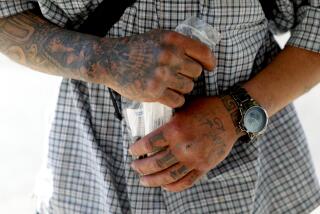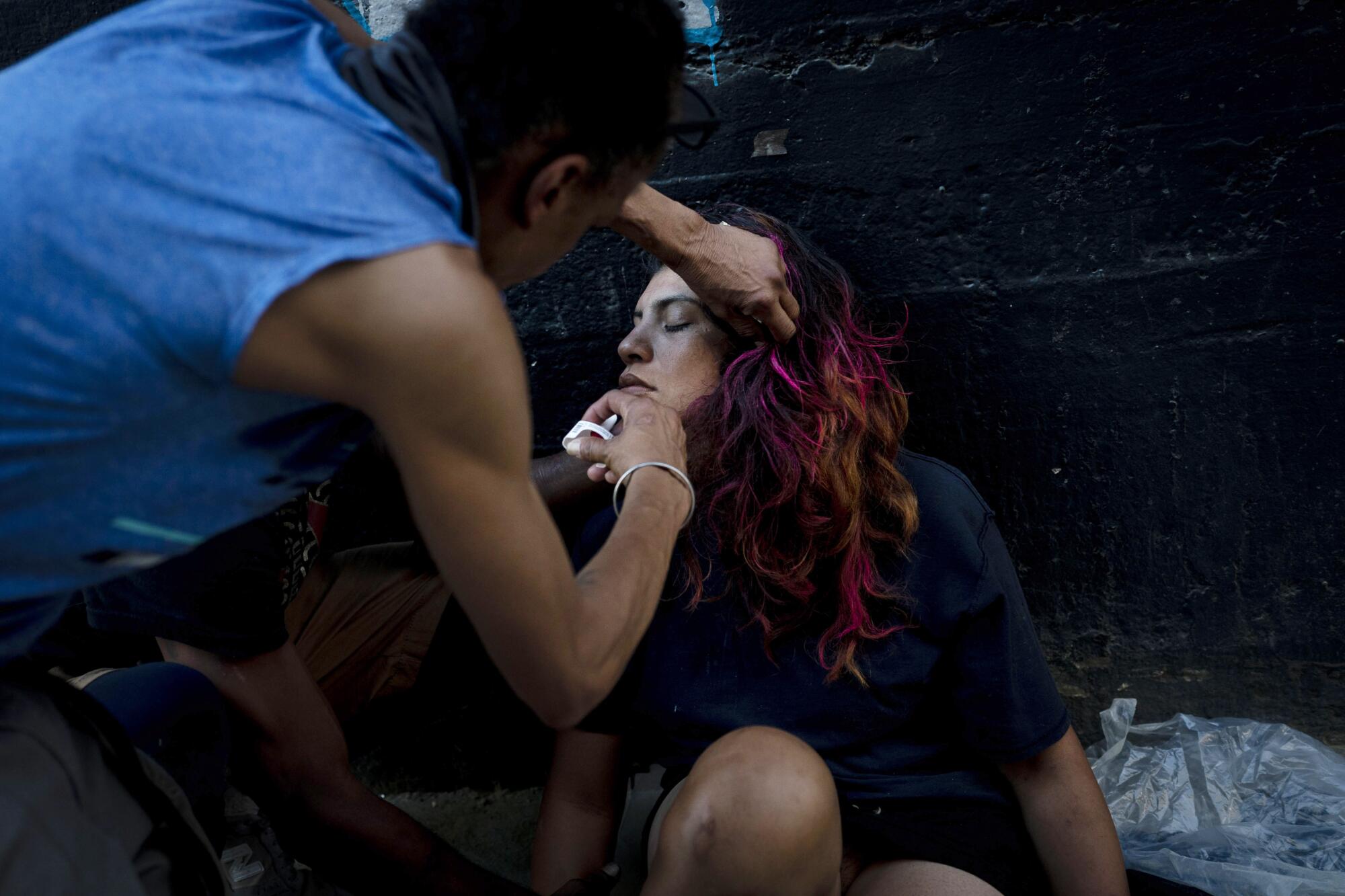
- Share via
As fentanyl overdose deaths rise unabated, California is at the forefront of the fight to reverse the grim trend. But organizations that distribute overdose reversal drugs worry that their increasingly bold efforts to save lives could land them in legal trouble.
Some, such as an outdoor center in San Francisco that opened in January, have generated wide attention. The facility — which in addition to distributing naloxone to opioid users helped connect them with social services — drew criticism from residents who claimed it encouraged drug abuse by allowing people to use on site. It closed earlier this month.
Other pioneering approaches have stayed mostly out of the spotlight. In a handful of major cities from Oakland to Los Angeles, plans are underway to expand how the reversal drug is distributed: outfitting residential buildings that house large populations of opioid users with boxes of Narcan, the brand name of the widely used nasal spray version, in addition to making it available in schools, libraries and jails.
Elsewhere, service providers want legal cover to distribute naloxone to people who may in turn share it with others who have not been trained to administer it.
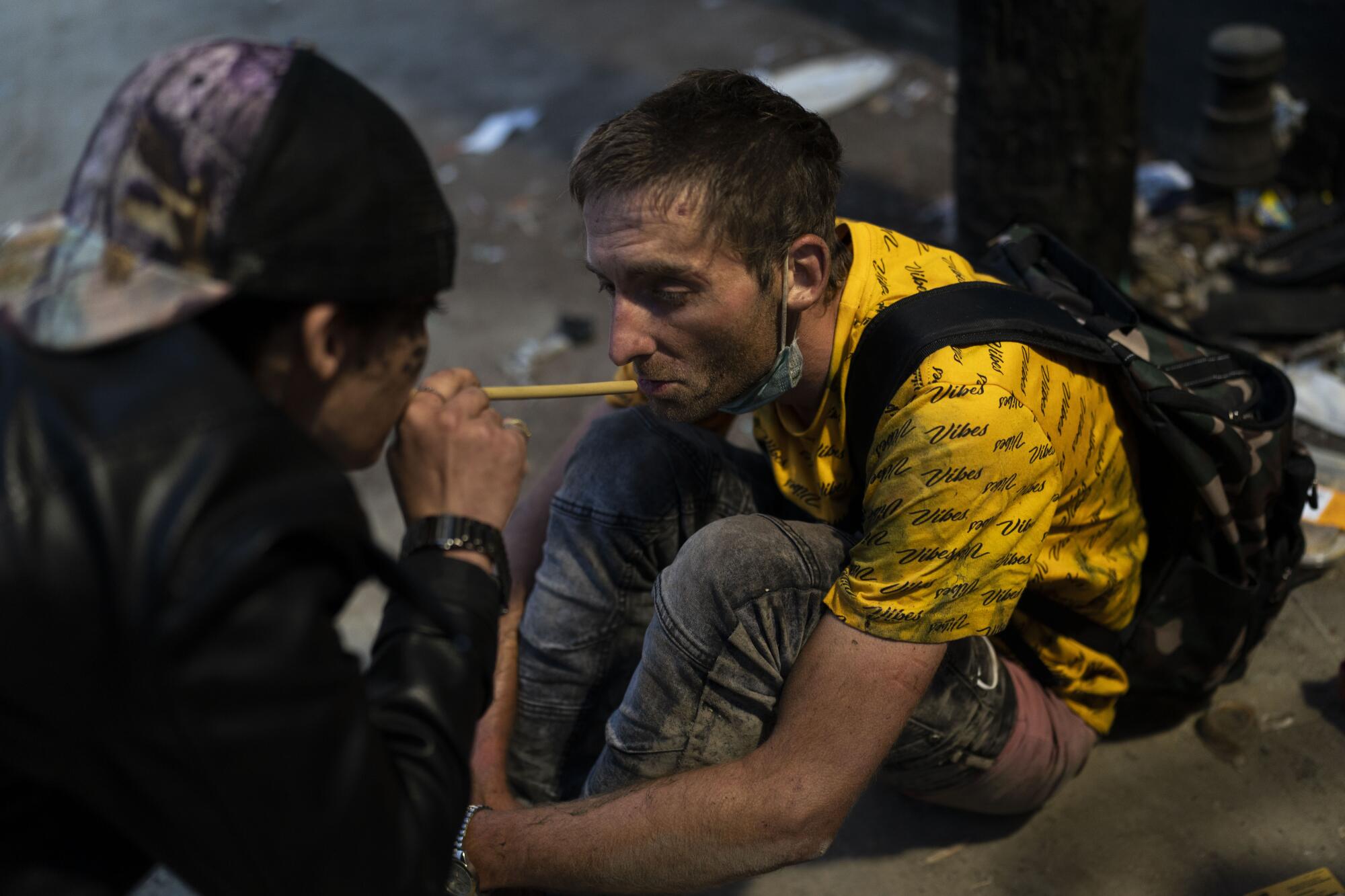
The initiatives are a sign of this desperate moment in America’s long-running overdose epidemic. The death toll has spiked in recent years, largely as a result of the growing ubiquity of the powerful opioid fentanyl.
The legally prescribed painkiller has become a popular illicit street drug over the last decade. It has also killed thousands of people who unknowingly consumed other drugs such as cocaine or heroin that were surreptitiously laced with fentanyl.
The U.S. Centers for Disease Control and Prevention has described fentanyl as up to 50 times as potent as heroin and 100 times as potent as morphine.
More than 71,000 people died in the U.S. of overdoses caused by synthetic opioids — primarily fentanyl — in 2021, an increase of more than 23% from the previous year. In 2012, the CDC recorded just 1,615 overdose deaths involving fentanyl in the U.S.
In the face of such distressing failure to reduce deaths from opioids, methods for addressing the crisis that many once considered too risky or even unthinkable are now being debated by state and local officials and rolled out in communities devastated by overdoses.
***
In San Luis Obispo County, a stretch of coastal California that’s home to fewer than 300,000 people, the number who died annually of opioid-related overdoses jumped from 21 to 55 between 2019 and 2020.

Today, every sheriff’s deputy in the county carries Narcan while on patrol. Anyone with a San Luis Obispo address can get naloxone mailed to their home for free by filling out an online form and checking a box stating that they’ve completed a basic training course on how to use the medication.
But some advocates and officials say naloxone is still not prevalent enough in the communities that need it most. Many drug users and their loved ones don’t know there are so few barriers to obtaining opioid reversal drugs in California, and others simply haven’t sought it out.
Homeless people typically can’t obtain naloxone via mail because they have no fixed address. Language barriers and fear of authority figures and law enforcement keep some people from seeking it out.
As executive director of a San Luis Obispo County nonprofit called the 5Cities Homeless Coalition, Janna Nichols has witnessed the lifesaving benefits of naloxone.
Before her organization kept Narcan on hand and she and her staff were trained to administer it, Nichols said, they had no option but to call 911 when clients exhibited overdose symptoms.
No one has died of an overdose at the nonprofit’s office in Grover Beach, about 15 miles southeast of downtown San Luis Obispo. Nichols wants to keep it that way.
So now, when “somebody is sitting in the lobby and clearly under the influence who’s lethargic and nonresponsive,” she said, 5Cities staffers administer Narcan instead of waiting for emergency responders.
Still, Nichols and her staffers aren’t there when people overdose at 3 a.m. in a dark parking lot, or at home with friends or family members. So she’s looking for ways to help.
She’d like to be able to give naloxone directly to drug users and encourage them to share it with others who may be untrained. In a perfect world, she’d erect stands or boxes containing naloxone — she likened them to “Little Free Library” boxes, but with opioid reversal medication instead of tattered paperbacks — in homeless encampments and other places where drug users congregate.

Academic research supports the idea that overdoses could be significantly reduced via secondary distribution, a term for the practice of giving naloxone to people who then pass it on to others who are relatively likely to witness an overdose. A 2018 study by researchers at the University of Pittsburgh found “adding secondary distribution through social networks to a single site resulted in 42.5% fewer overdose deaths.”
A spokesperson for the California Department of Public Health said the U.S. Food and Drug Administration is pursuing review of over-the-counter distribution because “naloxone saves lives.”
“The public health benefit of administering naloxone during an overdose far outweighs any potential risks related to naloxone side effects or risk of overdose death in the absence of naloxone,” the spokesperson said in an email.
5Cities is not the first organization to take an interest in offering naloxone to untrained people.
Boxes containing free doses have been installed in a handful of locations across California. But the few that have been installed are mostly at prisons and service providers’ offices, and they represent little more than a drop in the ocean of need.
For advocates and service providers across the state, concerns about liability stand in the way of their vision of a society with wide, easy access.
California law protects licensed healthcare providers and people with proper training from liability if they administer an opioid reversal drug in good faith to someone who is overdosing.
But there is less clarity about whether an individual, organization or agency could be held liable or sued if they give a naloxone kit to someone who has not been trained in its use — or who passes it on to an untrained person — who then administers it to someone who ends up suffering a negative reaction or dying.
Asked in an email about potential liability, the state Department of Public Health did not provide guidance beyond suggesting entities consult with their attorneys.
“I haven’t really gotten to the point of figuring that out,” said Nichols, of 5Cities. “Our staff are trained, and we carry it with us. If we see [an overdose] happening, we are covered to administer it. But the question is what if our staff hands it to somebody … and that person then uses it to help somebody else?”
***
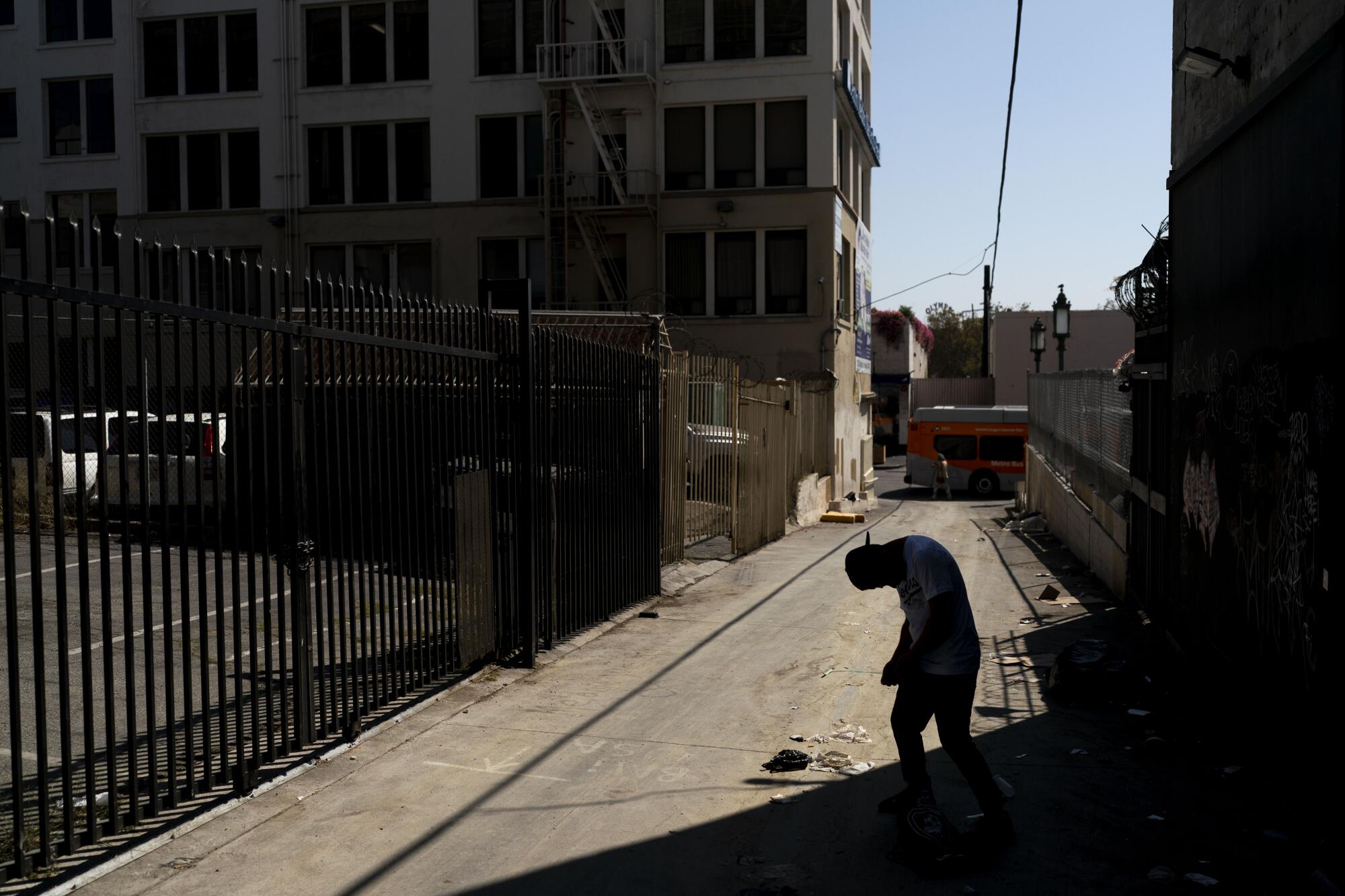
There were an estimated 6,843 overdose deaths related to opioids in California in 2021, according to preliminary data from the state Department of Public Health. Of those, 5,722 were fentanyl-related.
San Francisco made a bold push in January to bring down the death toll when it opened a “linkage center” in the city’s drug-laden Tenderloin neighborhood. The open-air site was pitched as a progressive effort to connect drug users with rehabilitative, overdose prevention and mental health services, as well as to help them find housing and provide food, showers and other necessities.
Days after it opened, news outlets confirmed that use of illegal drugs was being allowed at the center. The reports raised concerns about whether it was a de facto “safe consumption” site, rather than a place for drug users to obtain services and resources.
Earlier this month, Mayor London Breed’s office said more than 100,000 people had visited the center, which provided thousands of meals and showers and helped obtain shelter or housing for more than 1,000 people, the San Francisco Chronicle reported.
More than 300 overdoses were reversed at the center. But fewer than 1% of visits to the site connected people with addiction or mental health treatment.
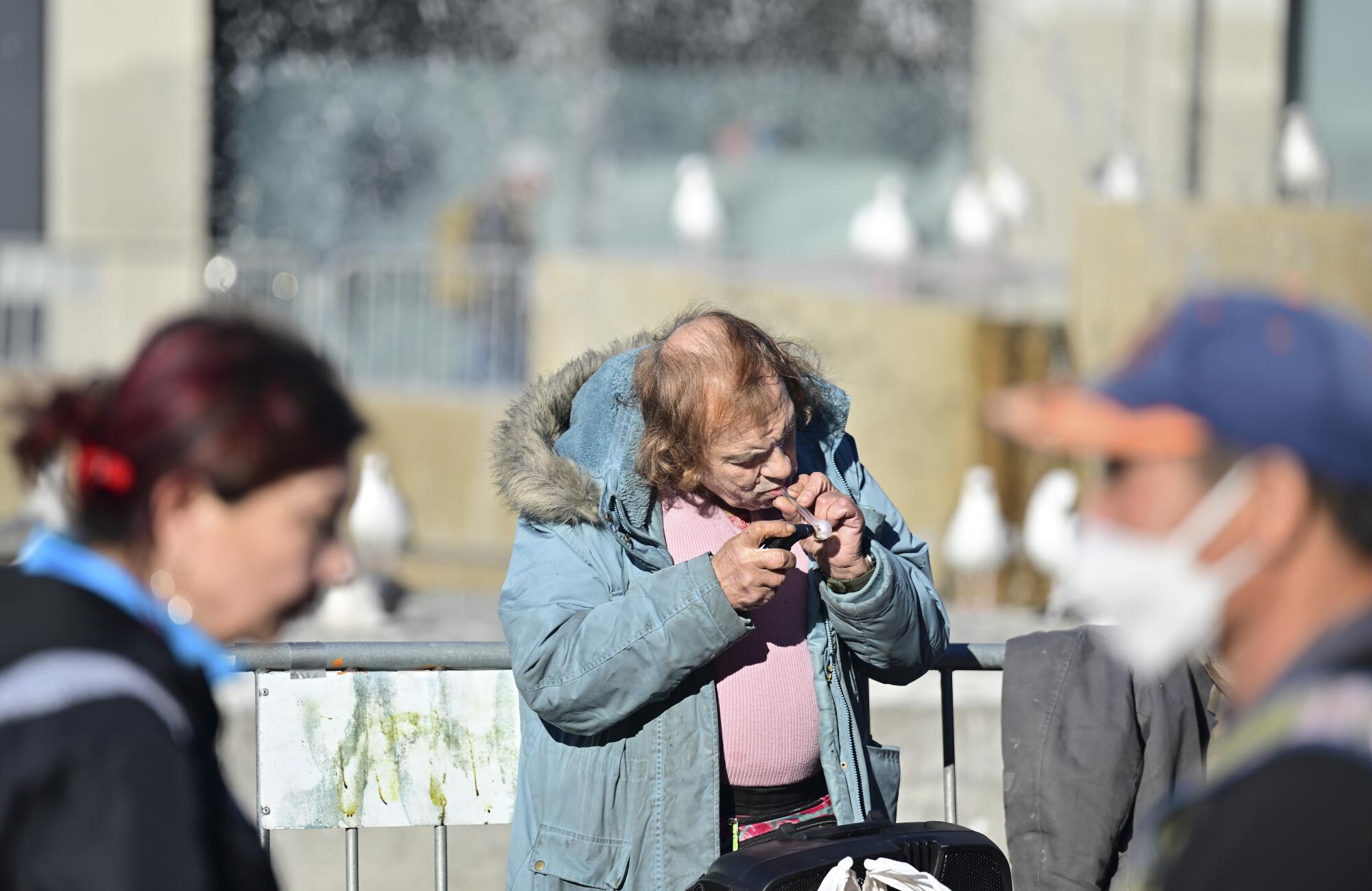
On Dec. 4, the center shut down, leaving drug users, service providers and other observers wondering what, if anything, will replace it and the help it provided in San Francisco. Similar questions face other communities across California seeing skyrocketing numbers of opioid overdose deaths.
Eleven days before he vetoed a safe consumption site pilot program, Gov. Gavin Newsom signed a bill allowing pharmacists to distribute new, more powerful and faster-acting opioid reversal agents once they have been approved by the FDA. The law makes it so such drugs would not have to be separately approved at the state level before pharmacists could distribute them.
The law is an important step toward ensuring that any new opioid-reversal drugs could be more quickly made available statewide, state Sen. John Laird (D-Santa Cruz) said last week. It could have a real impact on the fight to stop overdoses from killing people, he said, and it could incentivize pharmaceutical companies to develop opioid-reversal drugs.
“In the face of such a big crisis, we have to have every tool we can have available,” Laird said.
***
In Oakland, a pilot project will make naloxone available in transitional housing for homeless people who use drugs or have substance use disorders. Each of the building’s several floors will have a box containing Narcan that its approximately 120 residents will be free to take and use in the event of an overdose.
Jared Bunde is a registered nurse with Alameda County Health Care for the Homeless, one of the three service providers heading up the initiative. He said that though the project “hasn’t launched yet, we have the Narcan, we have the boxes. We have to install the boxes. And we have to see what the uptake is and if people actually use the boxes and take the naloxone.”
It’s a simple idea — making lifesaving drugs readily available to the people who need it most. But even Bunde said he’s not entirely sure whether his organization or others could open themselves up to liability by distributing naloxone directly to people who may not be trained in its use, or who may give it to others.

“Something I’d be looking for would be increased clarity around secondary distribution, because I don’t actually know. I don’t think anybody would get in trouble for it, but I wouldn’t want to give anything less than concrete advice,” he said.
Anthony Cava, a spokesperson for the California Department of Health Care Services, did not provide a direct answer to a question about whether providers could face liability for giving the medicine to untrained people.
“Through the DHCS Naloxone Distribution Project (NDP), qualified organizations and entities are able to request free naloxone and have it directly shipped,” Cava said in an email. “They are also required to receive training in opioid overdose prevention and treatment, and provide training to individuals who receive naloxone from them.”
In Los Angeles, the Homeless Outreach Program Integrated Care System, or HOPICS, is working to distribute more naloxone to unhoused people.
“We’re taking harm reduction to the streets to start saving lives,” said Veronica Lewis, the agency’s director. “From about April 2021 until now, we’ve reversed, based on our naloxone distribution to people living outdoors, almost 200 overdoses. We give out the naloxone to people who are probably using alongside the people who are overdosing.”
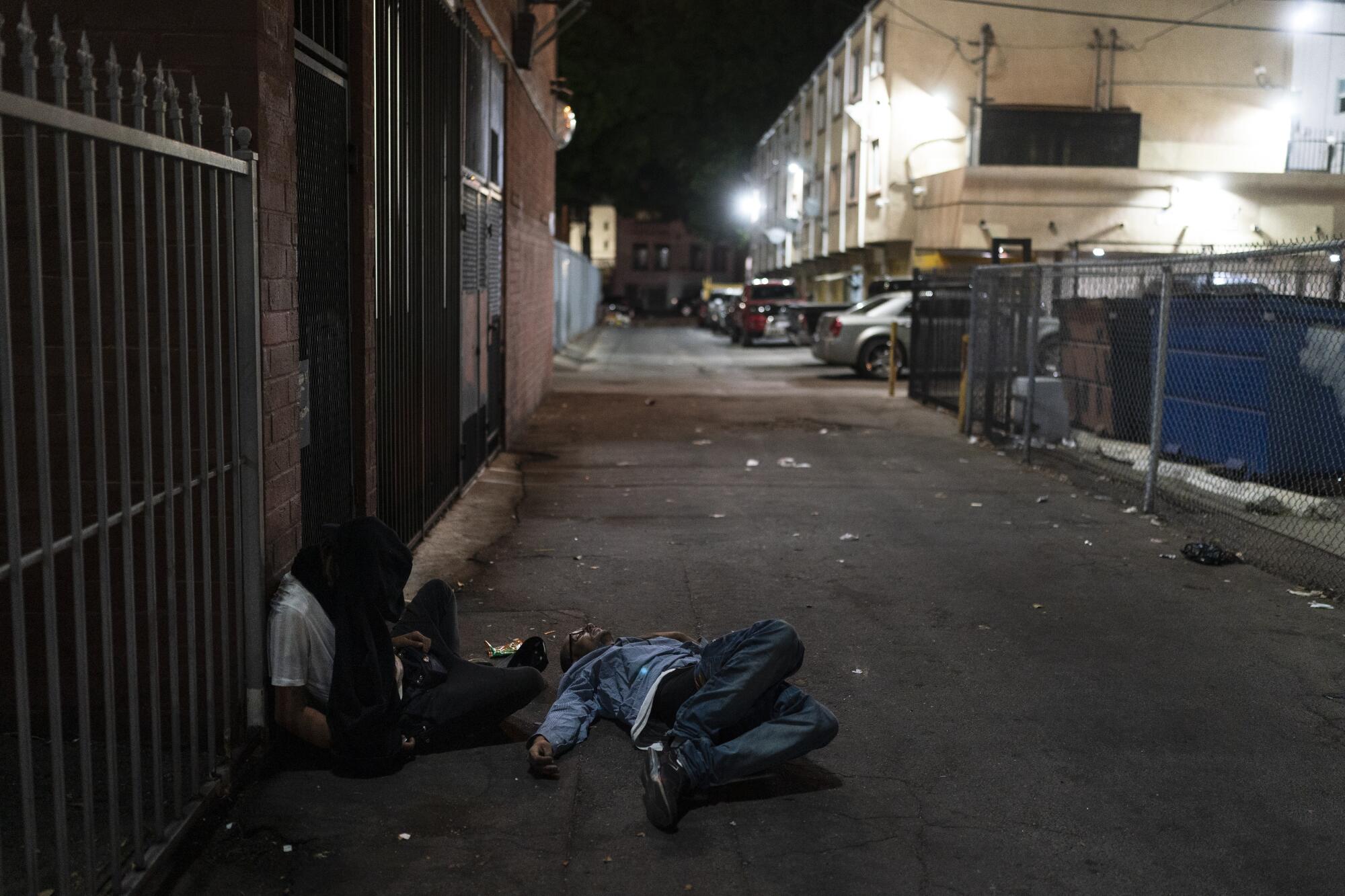
In Los Angeles County, attitudes about access to naloxone are changing fast. In the summer of 2021, the L.A. County Department of Health Services rolled out a program to hand out tens of thousands of boxes of Narcan.
Lewis said the medication will also be available in two permanent supportive housing projects under development in L.A. County.
But getting to this point wasn’t a quick process. Lewis said it took “about a year” to get the necessary approvals from the city of L.A. to hand out naloxone on the street. HOPICS also worked with the county to help it update its policies to allow service providers to distribute naloxone directly to homeless individuals and train them on how to administer it, she added.
Yet even now HOPICS doesn’t “pass it out to people to pass it out to other people,” she said. “We pass it out to people to use it.”
“There’s been a widespread push to get naloxone in more people’s hands. … I think we’re on our way there, we’re just not quite there yet.”
- Share via
Watch L.A. Times Today at 7 p.m. on Spectrum News 1 on Channel 1 or live stream on the Spectrum News App. Palos Verdes Peninsula and Orange County viewers can watch on Cox Systems on channel 99.
More to Read
Sign up for Essential California
The most important California stories and recommendations in your inbox every morning.
You may occasionally receive promotional content from the Los Angeles Times.



